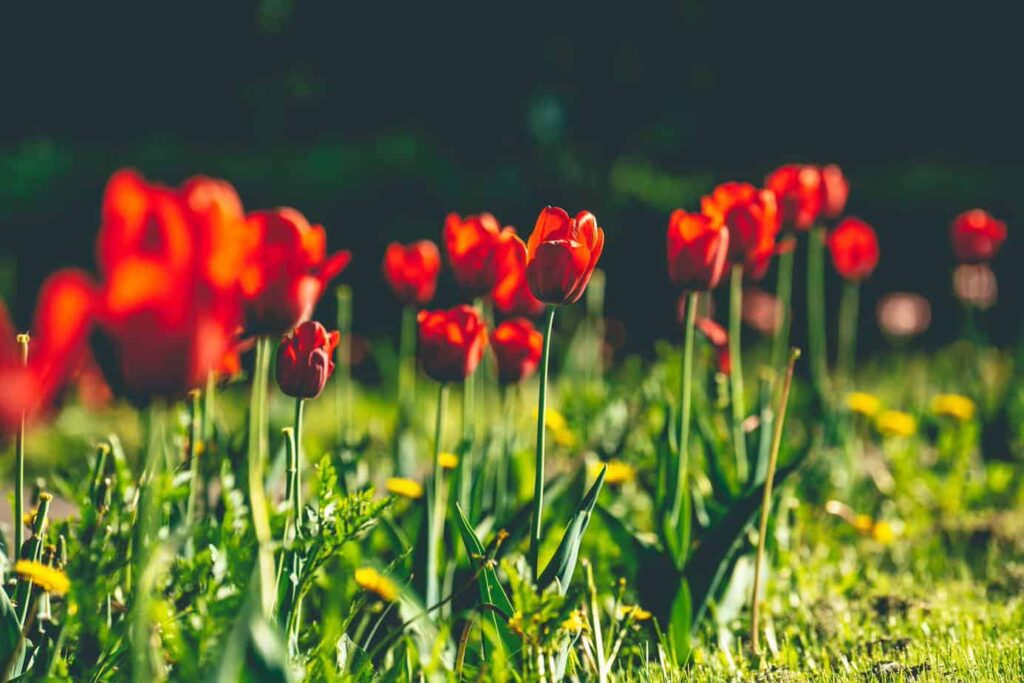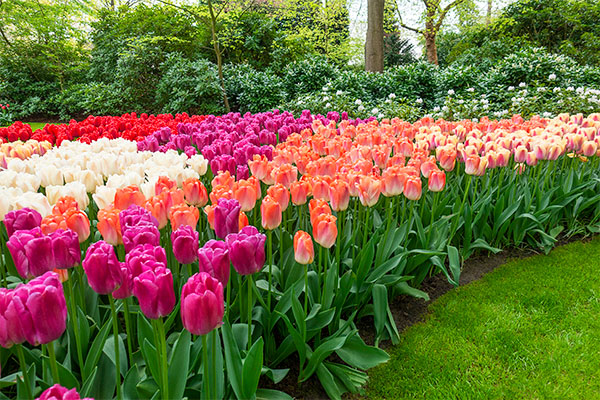Tulips are one of the most beloved blooms in gardens around the world. With their vibrant colors and delicate petals, they add a touch of beauty to any outdoor space.

But if you’re new to gardening, it can be hard to know when to plant tulips for the best results.
If you’re ready to learn how to get your garden ready for these stunning flowers, then this beginner’s guide is for you!
From choosing the right planting site to caring for your tulips after they bloom, this article will show you everything you need to know about when and how to plant tulips.
So let’s get started and see what it takes for these lovely blooms to thrive in your garden!
Is the tulip a perennial or an annual bulb?
Do you want to know whether tulips are annual or perennial bulbs?
The answer is that it depends on the type of tulip you choose.
Most species of tulips, such as Triumph and Botanical tulips, are annual bulbs, meaning they only last for one season.
However, a few types of tulips can be considered perennials in some climates.
These include late-blooming varieties such as Greigii and Kaufmanniana.
If planted in a warm climate with plenty of suns and well-drained soil, these types of tulips may flower again year after year.
It’s important to note that these perennials need to be planted in late fall and will usually not survive if planted too early or too late.
When it comes to planting tulips, it’s best to do your research so you know what type of bulb you’re getting and when the best time to plant them is for your area.
When should tulips be planted?
Tulips are a beautiful and versatile addition to any garden.
When it comes to when to plant tulips, the best time is usually in late fall between September and November.
Planting them too early or too late can result in fewer blooms or even no blooms at all.
When planting tulips, dig a hole that’s about six inches deep with plenty of space around the bulb for air pockets.
Place the bulb in the hole with the pointed end facing up and cover it with soil.
Water thoroughly after planting and mulch lightly over the top of the soil surface for added protection from cold temperatures.
For optimal growth, make sure you choose a spot that has direct sunlight for at least six hours per day but also provides some cool shade during the hottest part of the day for maximum flower production.
If you live in a warm climate, look for garden centers that sell potted plants so that you can easily move your tulips indoors during extreme temperatures.
Whether you choose species tulips such as Triumph or botanical varieties like Kaufmanniana, understanding when to plant tulips will ensure your garden is bursting with color come springtime!
How to Choose and Prepare a Planting Site for Tulips
When it comes to selecting a planting site for tulips, there are some important factors to consider.
Choose a spot that gets at least six hours of direct sunlight per day and is slightly shaded during the hottest part of the day for maximum flower production.
The soil should be well-draining, such as sand or loam, with a pH between 6 and 7.5. If possible, avoid areas near trees or shrubs since their roots can compete with your tulip bulbs for moisture and nutrients.
Once you’ve selected a site, preparing the soil is key to healthy tulip growth.
Turn over the soil with a shovel or tiller to a depth of about 8-10 inches, then add some compost or aged manure for extra nutrients.
To help retain moisture in dry areas, cover the garden bed with 2-3 inches of shredded bark mulch before planting your bulbs.
When you’re ready to plant your tulips, dig holes that are twice as deep as the bulb size and space them 4-6 inches apart.
Place each bulb in its hole with the pointed end facing up and fill in around it with soil so that no part of the bulb is exposed above ground level.
Finally, water thoroughly after planting and keep an eye on your flowers throughout their growing season!
How to Plant Tulips
Planting tulips is a fun and rewarding experience. To ensure successful growth, it’s important to select the right location and soil type before planting your bulbs.

Tulips prefer sunny spots that get at least six hours of direct sunlight per day, as well as well-draining soil such as sand or loam with a pH between 6 and 7.5.
Avoid planting in areas near trees or shrubs since their roots can compete for water and nutrients with your tulip bulbs.
Once you’ve selected a site, prepare the soil by turning it over with a shovel or tiller to a depth of 8-10 inches and adding compost or aged manure for extra nutrients.
Cover the garden bed with 2-3 inches of mulch to help retain moisture in dry areas before planting your bulbs.
When you’re ready to plant your tulips, dig holes twice as deep as the bulb size, spacing them 4-6 inches apart.
Place each bulb in its hole with the pointed end facing up and fill in around it with soil so that no part of the bulb is exposed above ground level.
Finally, water thoroughly after planting and keep an eye on your flowers throughout their growing season!
How Deep Do You Plant Tulip Bulbs?
Tulip bulbs should be planted at a depth of 8-10 inches, depending on the variety and size of the bulb.
For smaller bulbs like botanical tulips, you can plant them 6-8 inches deep.
For larger species of tulips, like triumph or late tulips, you’ll need to dig deeper holes of 8-10 inches to accommodate their size.
When planting your bulbs, make sure the pointed end is facing upwards and that no part of the bulb is exposed above ground level.
This will help ensure enough soil and moisture around the bulb so it can grow properly. To avoid air pockets in the soil, use a trowel to fill in around each bulb after planting.
Once all your bulbs are in place, give them good watering and wait for their beautiful blooms!
How to Care for Tulips
Tulips are a popular and beautiful flower that can add a splash of color to your garden.

To get the most out of your tulips, it is important to give them the proper care they need. In cold climates, tulip bulbs should be planted in the fall when temperatures drop below 50℉.
Plant each bulb in a hole 8-10 inches deep with the pointed end facing up.
Use a trowel to fill in around each bulb and water thoroughly after planting.
For potted plants, choose a cool spot away from direct sunlight and make sure it has good drainage.
Tulips prefer sandy soil with plenty of organic matter and need at least six hours of sunlight per day.
Water regularly to keep the soil moist but not soggy. Once your flowers have bloomed, deadhead them so they will continue blooming through the spring season.
With just a bit of care and attention, your tulip plants will reward you with stunning blooms for years to come!
Conclusion
When it comes to planting tulips, there are many things to consider.
From choosing the right type of tulip and finding the perfect spot in your garden to making sure you plant them at the right time and depth, there is a lot to think about.
Fortunately, by following these tips, you can ensure that your tulips will thrive and bring beauty to your garden year after year.
With proper care and attention, your tulips will reward you with stunning blooms for many springs to come!






